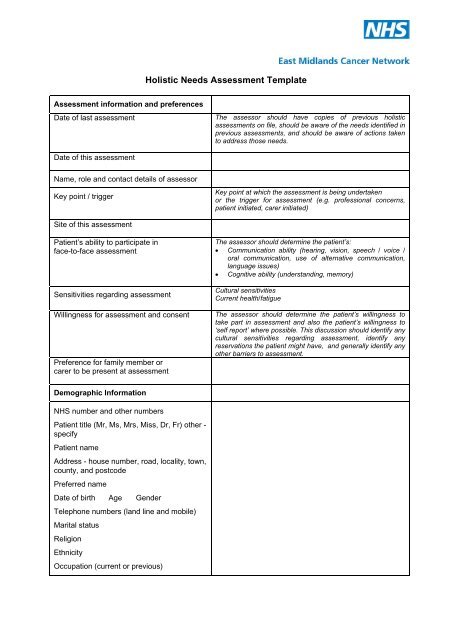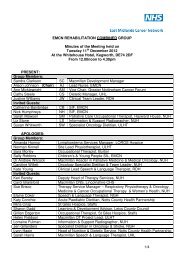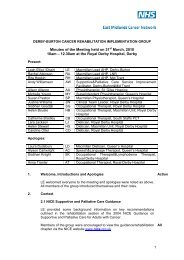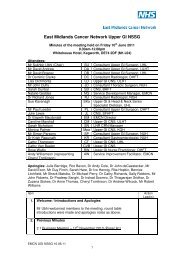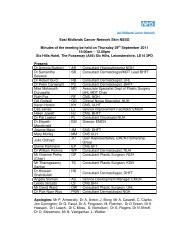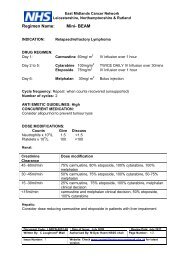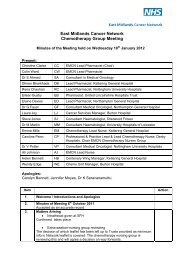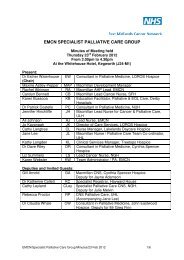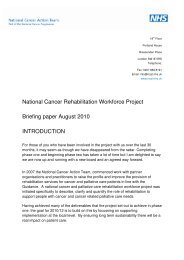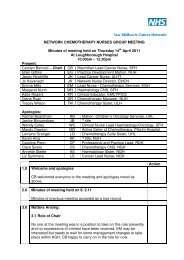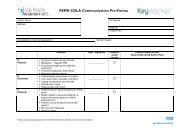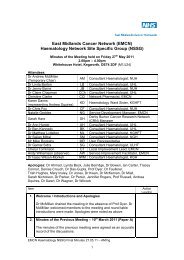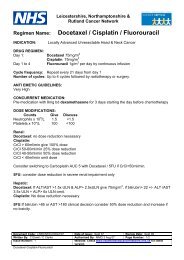Holistic Needs Assessment Template - East Midlands Cancer Network
Holistic Needs Assessment Template - East Midlands Cancer Network
Holistic Needs Assessment Template - East Midlands Cancer Network
You also want an ePaper? Increase the reach of your titles
YUMPU automatically turns print PDFs into web optimized ePapers that Google loves.
<strong>Holistic</strong> <strong>Needs</strong> <strong>Assessment</strong> <strong>Template</strong><br />
<strong>Assessment</strong> information and preferences<br />
Date of last assessment<br />
The assessor should have copies of previous holistic<br />
assessments on file, should be aware of the needs identified in<br />
previous assessments, and should be aware of actions taken<br />
to address those needs.<br />
Date of this assessment<br />
Name, role and contact details of assessor<br />
Key point / trigger<br />
Key point at which the assessment is being undertaken<br />
or the trigger for assessment (e.g. professional concerns,<br />
patient initiated, carer initiated)<br />
Site of this assessment<br />
Patient’s ability to participate in<br />
face-to-face assessment<br />
Sensitivities regarding assessment<br />
Willingness for assessment and consent<br />
Preference for family member or<br />
carer to be present at assessment<br />
The assessor should determine the patient’s:<br />
• Communication ability (hearing, vision, speech / voice /<br />
oral communication, use of alternative communication,<br />
language issues)<br />
• Cognitive ability (understanding, memory)<br />
Cultural sensitivities<br />
Current health/fatigue<br />
The assessor should determine the patient’s willingness to<br />
take part in assessment and also the patient’s willingness to<br />
‘self report’ where possible. This discussion should identify any<br />
cultural sensitivities regarding assessment, identify any<br />
reservations the patient might have, and generally identify any<br />
other barriers to assessment.<br />
Demographic Information<br />
NHS number and other numbers<br />
Patient title (Mr, Ms, Mrs, Miss, Dr, Fr) other -<br />
specify<br />
Patient name<br />
Address - house number, road, locality, town,<br />
county, and postcode<br />
Preferred name<br />
Date of birth Age Gender<br />
Telephone numbers (land line and mobile)<br />
Marital status<br />
Religion<br />
Ethnicity<br />
Occupation (current or previous)
Next of kin<br />
Relationship<br />
Address<br />
Telephone numbers (home, work, mobile)<br />
Other contacts (relationship, address, and<br />
telephone numbers)<br />
Identify who to call first in case of a crisis and<br />
whether they want to be contacted at night<br />
This has a legal meaning as well as a practical one - the next<br />
of kin may not be the person nominated by the patient to be<br />
telephoned first in case of crisis<br />
GP, practice address, telephone and fax<br />
number<br />
District Nurse, address, telephone and fax<br />
number<br />
Consultants (names and hospitals)<br />
Specialist palliative care nurses (hospital and<br />
community)<br />
Specialist nurses<br />
Social worker<br />
Other key professionals<br />
Clinical History<br />
Medical<br />
Diagnosis<br />
Primary site<br />
Site of metastases<br />
Month and year of diagnosis<br />
Tissue diagnosis (yes/no)<br />
Histology<br />
History of current illness<br />
(With dates/details of any surgery,<br />
chemotherapy, radiotherapy or endocrine<br />
therapy and response or adverse effects of<br />
these treatments)<br />
Past medical history<br />
Previous and current illnesses<br />
Drug history<br />
Allergies<br />
Resuscitation status<br />
This will need updating with each assessment<br />
Include all significant conditions e.g. non insulin dependent<br />
diabetes, ischemic heart disease.<br />
An accurate drug history that is regularly updated is essential.<br />
It is important to check what is and is not working and to go<br />
through patient’s concerns about their medication<br />
Teams have different ways of assessing this - a common way<br />
is for a doctor first to assess whether CPR would be futile, with<br />
a reason; if it is considered futile then many units do not go on<br />
to discuss it with the patient, unless they are known to want<br />
involvement in all clinical decisions. Often the question of CPR<br />
is raised within other discussions about future management<br />
and the aims of all treatments. The notes should say whether<br />
the matter has been directly discussed with the patient and/or<br />
their relatives (who should be named).<br />
Current problems<br />
Patient’s current problems discussed,<br />
including physical, psychological, social and<br />
spiritual problems.<br />
Specific tools such as pain assessment tools may be used.<br />
2
Information needs<br />
Preferred language - need for interpreter<br />
‘Would it be helpful for you to have an interpreter from the<br />
hospital or community when we come to talk with you’ 'Are<br />
you comfortable with X from the family translating for you’<br />
Any aids to communication needed e.g.<br />
hearing aid, Light writer.<br />
Current insight<br />
‘What do you know about your illness at the moment’<br />
Amount of information wanted<br />
How information should be conveyed and with<br />
whom present<br />
As a rule do you like to have a lot of information about your<br />
illness, or just really general information “<br />
Are you the sort of person who likes to know everything about<br />
your illness or are you the sort of person who likes to leave<br />
things up to the doctors and nurses’<br />
‘How do you like to get information about your illness - face to<br />
face like this, or written down’ ‘Is there anyone you usually<br />
like to be with you if we have to tell you the results of tests or<br />
discuss treatments’<br />
Wants / does not want copies of treatment<br />
plans<br />
‘Would you like copies of the letters we write to your GP’<br />
Preferred amount of involvement in decisionmaking<br />
and management planning<br />
‘How much do you usually like to be involved in making<br />
decisions about your treatment”<br />
Consent for sharing information with<br />
family/carers<br />
‘Are you happy for your family to know details of your illness or<br />
treatments Is it all right if we answer their questions without<br />
you’<br />
Consent for sharing information with other<br />
professionals/ entering on patient record<br />
system.<br />
‘Are you happy for what we’ve discussed to be shared with<br />
other members of the team/other professionals such as your<br />
GP or District Nurse’<br />
Need to make sure they understand the extent the notes are<br />
shared.<br />
Social<br />
Practical living arrangements<br />
Work<br />
Finances<br />
Benefits<br />
Legal arrangements<br />
Type of accommodation(house, flat), access (access to<br />
entrance, stairs), toilet and bathroom (upstairs,<br />
downstairs),transport, mobility in and out of house<br />
Whether in nursing home or residential home, or staying with<br />
relatives<br />
Ability to carry out household duties e.g. preparing food,<br />
shopping, cleaning, laundry, manage pets<br />
Any issues around work<br />
Any concerns about finances<br />
Patient receiving appropriate benefits Including DLA or Carer<br />
Allowance (under the special rules if prognosis less than 6<br />
months)<br />
E.g. Will made or not, Advance Decision to Refuse Treatment,<br />
Lasting Power of Attorney, plans for care/guardianship of<br />
3
children.<br />
Services involved<br />
Interests<br />
This should include all agencies involved when at home and<br />
some detail about the level of services provided. Does the<br />
patient attend day care Are patient and carer aware of the<br />
out of hour services available locally e.g. Rapid Response<br />
Services<br />
Identify things patient has had to give up because of illness.<br />
Identify things patient would still like to do.<br />
Habits<br />
Psychological<br />
Mood –Depression, anxiety, anger, despair<br />
Coping mechanism for illness<br />
Effect of illness – body image, on<br />
relationships, on interests.<br />
Spiritual<br />
Spiritual needs<br />
Religious needs<br />
Restrictions related to culture or belief system<br />
Rehabilitation needs<br />
Impact of illness on activities of daily living<br />
Smoking, drinking<br />
‘How are you feeling about all this’<br />
Use of the Distress thermometer)<br />
The distress thermometer adapted for EMCN attached as<br />
Appendix E can be used to measure distress but should only<br />
be used by health care professionals who have undertaken<br />
level 2 training.<br />
‘How are you coping with all of this’<br />
‘How do you feel when you see yourself in the mirror’<br />
Consider using a spiritual need assessment proforma<br />
Start assessment with an introductory, exploratory<br />
question to determine patient’s existing faith/belief<br />
Someone to speak to: faith leader or minister e.g. chaplain,<br />
vicar, priest, imran, rabbi, church leader or other person.<br />
Religious items e.g. religious texts, prayer mat, religious<br />
objects, holy water.<br />
Things to help you practice e.g. chapel, prayer room, quiet<br />
room, ablution.<br />
‘Do you belong to any church’<br />
Diet. Medicines. Treatment products e.g. blood products<br />
Consider using a scale such as Modified extended Activities of<br />
Daily Living<br />
Ability to carry out personal care e.g. wash and dress,<br />
personal hygiene, manage medication<br />
Dietary needs/preferences<br />
Ability to carry out key transfers e.g. get in and out of bed, on<br />
and off chairs, on and off toilet, in and out of bath/shower<br />
Mobility around house and outside<br />
Does the patient have specific dietary needs e.g. diabetic,<br />
gluten free, kosher, halal, vegetarian.<br />
Specific tools may be helpful e.g. nutrition screening<br />
Complementary therapies<br />
Complementary therapies patients enjoys.<br />
Physical assessment of the patient<br />
Appropriate assessment by doctor, nurse and<br />
4
other<br />
health care professionals at the appropriate<br />
times<br />
Carer and family needs<br />
Name and relationship<br />
Insight into illness<br />
Any specific worries or concerns<br />
Level of involvement in care<br />
How other members of the family are coping<br />
e.g. children, elderly parents<br />
<strong>Needs</strong> – practical, emotional<br />
Sexual relations<br />
Bereavement needs<br />
Goals/Expectations<br />
Summary of problems and plans<br />
Advance care plans<br />
Advance statement<br />
Advance decision to refuse treatment<br />
Personal Welfare Lasting Power of Attorney<br />
See Appendix C for how to draw a genogram. The genogram<br />
should include family, children, and 'any significant others.'<br />
Conflicts/communication issues within family<br />
Is help needed talking to children about cancer, does the<br />
school know of child’s relative’s illness, children coping<br />
Sexual difficulties caused by illness or treatment<br />
Patient’s concerns or desires regarding a goal they may want<br />
to achieve e.g attending a family wedding, going on holiday.<br />
Expectations during the admission or visit should be checked<br />
regularly<br />
When you think it is appropriate, it is helpful to ask where the<br />
patient would like to die, then to record this and let other<br />
healthcare professionals know<br />
This should be a list of the major concerns of the patient - the<br />
things that are stopping them living in the way they would like.<br />
It is usual to list them in the patient's order of importance.<br />
Need to summarize plans to help with each problem.<br />
A statement of wishes and preferences<br />
about their future management or place of care<br />
A specific refusal of treatment(s) in a predefined potential<br />
future situation<br />
Where another person has been given authority to make<br />
health and welfare decisions for a patient when they lose<br />
mental capacity<br />
End of Life care tools<br />
End of life care tools should be implemented as necessary –<br />
Gold Standards Framework, Liverpool Care Pathway.<br />
5
GENOGRAMS<br />
Male ( died)<br />
Pregnancy<br />
Female (<br />
died)<br />
X or X Patient<br />
Married<br />
Separated<br />
Twins<br />
Divorced<br />
Cohabitng<br />
Homosexual<br />
Relationship<br />
Adoption<br />
1 st 2 nd 3 rd<br />
X<br />
1st, 2 nd and 3 rd Marriages<br />
Parents<br />
Ron Elsie Sam Tom Jim Mary Jack Joan<br />
X<br />
Live in<br />
Peter Ann Kim Joanna John James Sheila Emma Paul<br />
same house<br />
18 16 14 7 6 22 18 18 14<br />
It is important to keep each generation on its own line<br />
6


